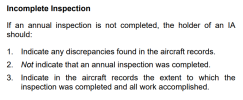I recall being trained that once an annual inspection has started, an airplane is no longer considered airworthy until the inspection has been completed (including paperwork). Even if the plane would have still been within the annual inspection due date if the annual had not been started. Today, however, others at the airport claimed that as long as it is still within the due date month, the plane may be "partially" inspected, flown, and then the annual completed.
For example, a plane is due for its annual by the end of January 2024. An annual inspection of that airplane is started on January 10th and the engine portion is completed on the 11th and the cowl buttoned up. The owner then flies the plane for several days, and returns it on the 15th for the annual inspection to be completed. Were the flights between the 11th and 15th legal?
More extreme would be the same example where the annual is started on the 10th, but all the inspection activities are completed by the 15th. At that point the IA falls seriously ill before the paperwork and logbook entries for return to service are completed and he/she is unable to complete them. May the plane be legally flown prior to January 31 without completion of the paperwork and log entries (i.e., since it is still within the 12 month limit for the old annual inspection)?
Please include the regulatory basis for your conclusion, as my colleagues will not accept a response without that.
Thanks. BTW, I apologize if this has been discussed. I tried searching both here and more widely, and got lots of hits relating to planes that are past their annual due dates, but wasn't able to find any that addressed this specific situation.
For example, a plane is due for its annual by the end of January 2024. An annual inspection of that airplane is started on January 10th and the engine portion is completed on the 11th and the cowl buttoned up. The owner then flies the plane for several days, and returns it on the 15th for the annual inspection to be completed. Were the flights between the 11th and 15th legal?
More extreme would be the same example where the annual is started on the 10th, but all the inspection activities are completed by the 15th. At that point the IA falls seriously ill before the paperwork and logbook entries for return to service are completed and he/she is unable to complete them. May the plane be legally flown prior to January 31 without completion of the paperwork and log entries (i.e., since it is still within the 12 month limit for the old annual inspection)?
Please include the regulatory basis for your conclusion, as my colleagues will not accept a response without that.
Thanks. BTW, I apologize if this has been discussed. I tried searching both here and more widely, and got lots of hits relating to planes that are past their annual due dates, but wasn't able to find any that addressed this specific situation.




